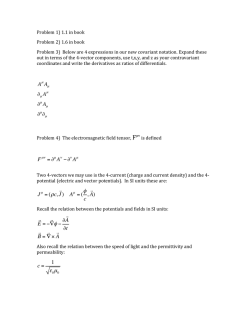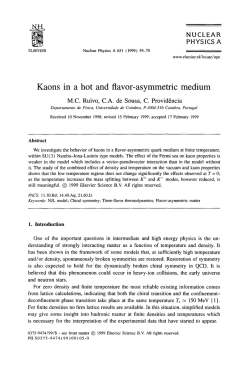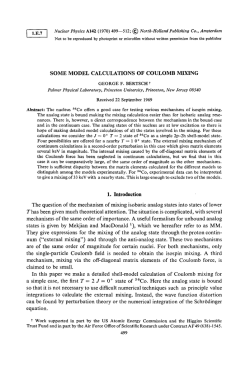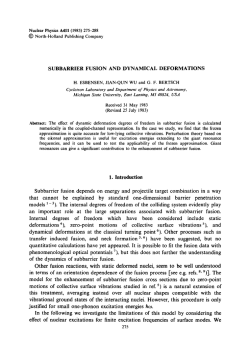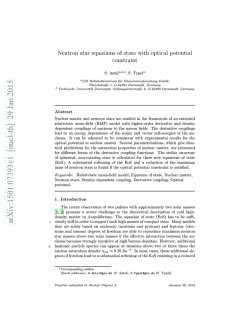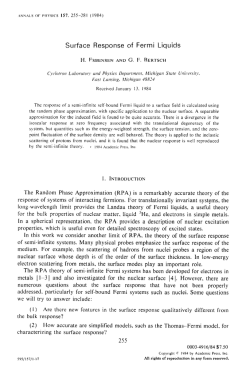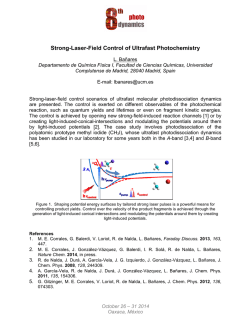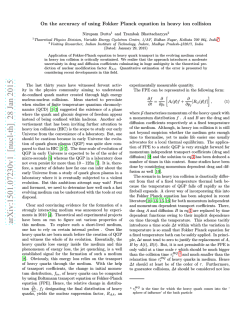
123. - Institute for Nuclear Theory
NUCLEAR PHYSICS
DECEMBER 1985
THIRD SERIES, VOLUME 32, NUMBER 6
Coulomb energy systematics and the missing
J=
'
—,
+ state in 98
R. Sherr
of Physics,
Department
Department
Princeton
University,
Cr. Bertsch
of Tennessee, Knoxville, Tennessee 37996
(Received 22 July 1985)
of Physics,
University
%'e study the energy systematics in
single-particle character. For many
Ehrmann shift is described very well
partner in 8 of the 2 state in Be is
light mirror nuclei of the unbound states having predominant
levels in the mass range 3 =9 17, the observed Thomasby a simple potential model. %e speculate that the missing
observable as a broad continuum with a peak at 0.9 MeV.
I. INTRODUCTION
Many experiments have been carried out in the past 25
years to look for the analog in B of the 1.685 MeV,
'
—,
state in Be. The first excited state in B has been
reported at various locations between 1.2 to 1.7 MeV, and
it has occasionally been presumed to be that analog. A
state is listed in the most recent compilation'
by
Ajzenberg-Selove at (1.6) MeV with a width of 700 keV,
but no
assignment is given.
The search for low-lying states in B is made very difficult because all states are particle unbound. The ground
state and the —' deformed state at 2.36 MeV have small
'
—, levels have widths
widths, but all other
greater
than 400 keV. The situation is similar for Be which, except for the ground state, has only particle unbound
= —,' at
states. The first excited state of Be, with
1.685 MeV excitation, has a width of 150 keV and is unbound by 20 keV. Because this is a single-particle state in
s-wave scattering the resonance does not have the usual
Breit-signer line shape, but is very skewed.
Bauer et aE. have reviewed the experimental evidence
for a broad state near 1.5 MeV in the reactions Li(a, n),
Be(p, n), and ' C(p, a). They conclude that decays into
three- and four-body final states obscure the 1.5 MeV region for a possible weakly excited level. Similar probarise in other reactions such as ' B(p,d),
lems
B( He, He), and Li( He, n).
The charge exchange reaction has also been used to investigate the low-lying spectrum of Be. Ueno et aI.
studied the reaction Be( He, t) at bombarding energies between 5.5 and 7.8 MeV, and did not find a resonance near
1.6 MeV. Instead, they found a relatively strong broad
continuum starting at the ground state and reaching a
J=
J
,
Princeton, Xeiv Jersey 08544
T=
J
—
maximum below 2 MeV of excitation. The yield is quite
forward peaked, and the maxim'um moves to higher energy as the bombarding energy is increased. The continuum
was well fitted by a description in which four-body phase
space
p) was multiplied by a Coulomb penetrability factor for the triton and the mass 9 system. Recent measurements of the ( He, t) reaction at 90 MeV (Ref.
8) also show no sharp features at 1.6 MeV. However, in
this work, the continuum is interpreted as a broad state
(I =1.0+0.2 MeV) at 1.65+0.03 MeV excitation, and is
presumed by the authors to be the analog of the 1.68
(a+a+ t+
J
'
MeV, = —, state of Be.
+
We shall question here whether the analog of a —,
state in Be at 1.68 MeV could be at about the same excitation in B. The main point is that if it were a singleparticle 2s&&2 state, one would expect its excitation energy
to be considerably lowered by the Thomas-Ehrman effect. The possibility of a lower energy for the state was
raised in Ref. 7, and also by Barker and Treacy who fitwith a density-of-states function
ted a ( He, a) spectrum'
for an s wave state at E=1.2 MeV and a width of 1.0
MeV. However, this reaction is not favorable because of
the low 2s~~2 probability in the B ground state wave
function.
In this paper, we calculate the location and shape of the
level in 8, using a single-particle potential model.
Qur intention is to guide future experiments by providing
estimates of the position, width, and line shape of the
state. In the course of this study, we found that our computations covering a range of light nuclei gave a satisfactory overall description of the widths and Coulomb shifts
of single-particle states. Since it is more complete than
previous studies, we will present our calculations for these
other nuclei as well.
"
1809
1985
The American Physical Society
R. SHERR AND G. BERTSCH
1810
The first comprehensive study of Coulomb displacement energies of analog states with potential models was
They used a Woods-Saxon poby Nolen and Schiffer.
tential, constraining the radius and depth to reproduce the
empirical neutron binding energies. They determined the
radius of the Coulomb potential from the measured
charge distributions of the closed shell cores. Their computed displacement energies were always smaller than the
experimental values (by 4% to 9%). Numerous correction
terms failed to remove this anomaly. On the easier question of the relative energy shifts of excited states, they
found very good results for the 2si/z states in A =13 and
"
17.
A simpler
'
approach was used in earlier papers by
Nolen, Schiffer, and their collaborators. '
Instead of
that the Coulomb potential fit the known
demanding
charge distribution, it was only required that the ground
state Coulomb energy be reproduced. In a study of the
(1f7/2) ground states of the odd Ca isotopes, they
then predicted the Coulomb displacement energy for the
p 3/p excited states correctly (to within 26 keV). In another study, Schiffer'" used Woods-Saxon potentials to calculate the widths of unbound proton states, finding reasonable agreement for the unbound orbits in ' N and 'Sc.
Tombrello' had also made a study of Coulomb displacement energies using Woods-Saxon potentials of fixed radius.
II. CALCULATIONS AND COMPARISON
WITH EXPERIMENTAL DATA
In the present investigation, we use the Woods-Saxon
potential model in its simplest form (i.e., constant radius
and diffuseness parameters) to compute excitation energies and widths of mirror states. Throughout our computations, we use the potential
V(r) =
1+exp(r
roA '/
)la—
with parameters ro ——1.25 fm and a=0.65 fm. The well
depth is usually chosen to fit the binding energy of the
neutron (if bound) and the proton energy is then calculated for the same Vo, including a Coulomb field of a uniform spherical charge of radius roA ' . Unbound states
appear as resonances. For some mirror pairs that are proton unbound, we fit Vo to the proton level so that its
width can be compared with experiment. As our goal is
to predict the broad s~&2 and p&&2 resonances in B, we
shall be content with 100 200 keV accuracy in reproducing known energies in other nuclei.
—
A.
A
=11, 13, 15, and
17 mirrors
To test the simple potential model, we first carried out
computations of mirror states for A=11, 13, 15, and 17.
For A = 13 and 17, the single-particle energies were calculated relative to the (0+,0) ground states of ' C and ' O.
However, for A = 11 and 15, the ground state spins of the
' 8 and ' N cores are nonzero, and, furthermore,
stripping
32
experiments and model calculations show that the lowest
i+
5 +
excited —, , —, , and —, states are predominantly s1ngleparticle levels relative to (0+, 1) states of the cores. We
therefore use binding energies relative to the (0+, 1) excited
level of B or N for A=11 or 15.
Our results for all the nuclei are summarized in Tables
I and II. We first discuss the cases in which the states are
bound or else well-defined
resonances, deferring consideration of the broad states of A=9 until later. Table I
lists the experimental and calculated values of excitation
energies and level widths of only those states that have
largely single-particle character. These excitation energies
are also shown in the level diagrams of Figs. 1 and 2. The
experimental widths in the references given usually correspond to FWHM; our computed widths are also FWHM
values.
For A=11 and 15, all the states are bound, and the
differences between calculated and experimental excitation
energies are no larger than 100 keV for A=11 and 200
differences in
keV for A = 15. The corresponding
Coulomb energies listed in Table II are at most 4% of the
ground state Coulomb energy difference for A= 11 and
10% for A=15. The agreement is better than should be
expected, considering the doubtful assumption that the
levels are pure single-particle states coupled to odd-odd
0+ core configurations.
5 +
For A=13, the —, + and —,
proton states are unbound
resonances. A resonance may be defined in principle as a
pole in the scattering matrix, with the resonant energy being the real part of the pole's position. This definition is
not easy to apply, so in practice, more convenient
are used for the resonant energy. One
prescriptions
prescription, employed in Ref. 16, is to take the energy
that maximizes an appropriately normalized wave function amplitude inside the nucleus. We apply this prescription by evaluating
f
WE(r)
r
dr,
where iIIE(r) is a continuum wave function for the singleparticle state at energy E with respect to (core plus nucleon). It is normalized by
sin(kr + 5)
v kr
(3)
The integral (2) provides a line shape for the excitation of
a single-particle level by a surface-peaked reaction mechanism. The width of the level is taken to be the FWHM of
(2). In Fig. 3(b), we show some results of this method by
the curves labeled o.. Neither the energy nor the width
will be the same as for Breit-Wigner fits of the elastic
scattering resonance line shape, but for I &&Eb, the
differences will be negligible.
The same remarks hold for another practical definition'
of the resonance, namely the energy at which the
rate of increase of the nuclear phase shift is a maximum.
Some results of this approach are illustrated by the curves
labeled d5/dE in Fig. 3(b). We shall discuss Fig. 3 in detail later on. For the present, we note that for the ' C-' N
'
COULOMB ENERGY SYSTEMATICS AND THE MISSING. . .
TABLE I. Single particle states in mirror nuclei A =9 to 17. Experimental and computed excitation
energies and the widths (FWHM) for unbound levels are listed for the Z& member of the pair in the
fourth and fifth columns. Those for the Z& member are given in the sixth and seventh columns. The
potential well depth Vp is given in the eighth column, while the references for the experimental data are
listed in the last column.
E&
(MeV)
'Be-'B
3
expt.
2
1
+
2
calc.
expt.
calc.
expt.
1
2
5+
2
calc.
expt.
calc.
11B 11C
3
2
1
+
2
13C 13N
1
2
1+
2
5+
2
1
calc.
expt.
5+
2
1+
2
170-17F
+
2
3
2
'Centroids.
+
230
1080
0.93
(2.6)
1400
(1650)
—1300
2.40
2.79
-2400
2. 81
580
180
1,8
56.3
1,23
28.4
73.6
59.7
2. 15
6.34
55.9
6.35
6.91
6.97
79.3
81.7
0
—0.07
2.37
39.6
33
2.37
25
3.55
3.44
47
0
0
calc.
expt.
calc.
expt.
calc.
expt.
calc.
0
+ 0.025
0.495
0.40
0.87
0.87
57.3
61.6
0
0. 15
5.24
5. 14
5. 18
4.98
expt.
calc.
expt.
41.5
2.00
calc.
calc.
expt.
Ref.
550
0
0.
+ 08
0
0
5.27
5.27
5.30
5.31
expt.
2
1.70
2.78
2.80
3.05
2.95
0
0
3.09
3.35
3.85
3.85
calc.
expt.
calc.
15N 150
(- 1000)
expt.
calc.
5
0.5
1.3
1.65
7. 19
1+
0
0
(MeV)
(keV)
150
calc.
expt.
calc.
expt.
(MeV)
1.69
expt.
2
2
0
0. 10
0
0
2. 12
2. 12
6.79
6.77
7.29
expt.
calc.
Vp
(keV)
19
50.7
69.9
69.3
57.4
53.8
5.09
96
5. 10
1530
5. 10
5.87
5.86
120
4.63
1200
45.0
480
5.60
5.50
1720
42. 5
R. SHERR AND G. BERTSCH
1812
I
3.20
B(0')+ n
10.43
B(0
7.29
5/2+
.
(
—
)
(-o.o2)
6.79
69
-------(
I
-. -----(
6.34
I
32
9.6
3.14
N(2. 3I, O')+
).p
2 2
I
p
n
O. O6)
O.OI)
I
5
/2
30
5. IB
------(-0 20)
5/2+
/2
I
N(0')
5o27
5.24
- --(-O. 0)
———
l
2.00
---- -----(.
O. OB)
-----(~0 08)
3/2
I
————— (+ O. I
/2
5)
l50
B
C
IO—
Additional
3/2+
levels
4.95
l2
C+n
3/2
CE NTROI
5/2' 3.85
5
87
D
.
+
/2~
3/2
3.09
'. 2.37
--—
- (-O. I7)
I.94
l2
5.09
-~60
——---- (-010)
5.)0
--~--
(-0.«)
4. i 46
«0+ n
cep
+
0+87
0.4 95— —
----0.09)
(
0 P7)
l3
l3N
---- -- (+0.03)
5/2+
&7O
0. 601
l6 0+ P
17F
FIG. 1. Energy level diagrams for mirror states in A =11, 13, 15, and 17. Only the levels having predominant single-particle character are shown. For 2=17, the lowest six 2 states and their centroids are shown. Calculated values are displayed as dashed lines
together with their displacement from the experiment'al values; (Energies are in MeV. )
mirror nuclei, both prescriptions give the same results
within our desired accuracy. The resulting Coulomb displacement energies shown in Table II are consistently low,
but no more than 260 keV. The very large shift of the
state relative to the ground state (this is the famous
case studied by Thomas and by Ehrman) is reproduced to
within 190 keV. The widths of the unbound proton states
are, of course, very sensitive to the energies. We therefore
fit the potential to the proton-resonant energy rather than
the neutron binding energy for this case. It may be seen
from Table I that the widths agree quite well for both the
'
and —, states, confirming their predominant singleparticle character.
In the case of ' 0-' F, the agreement is good for the
]+
5+
bound —, and —, states. The only major failure of our
',
model so far appears to be for the lowest —
resonances
in this mirror pair: the calculated ' F energy is 470 keV
low. These states are high enough in the spectrum so that
they mix significantly with other —, states. We find
much better agreement between calculation and experi-
COULOMB ENERGY SYSTEMATICS AND THE MISSING.
TABLE II. Coulomb displacement
1p1/2, 2s1/2, 1d5/2, and
'B-'Be
1 d3/2
3
2
AE expt.
hE calc.
1.86
1.76
+
2
(1.8)
1.16
11C 11B
hE expt.
hE calc.
13N 13C
b, E expt.
hE calc.
2.77
2.85
2.65
2.79
1
5+
2
2
1.47
1+
5+
2
2
2.32
2.35
1
5
2
2
3.01
2.94
1.60
1.72
(1.7)
2.39
2.55
+
2.28
2.02
2.69
2.58
3.41
3.20
3.50
3.40
1813
ment if we consider the reduced-width-weighted
centroids
as was done by Nolen and Schiffer" for the 2p3/2 states
in 2=41. The extra —,
T = —,' states' are shown in
Fig. 1(d); their single particle strengths were measured in
Refs. 18 and 21. The clumping near the lowest states
(which have 69% and 51% of the Wigner limit, respectively) arises because the spin-orbit splitting is roughly the
The comsame as the excitation of particle-hole states.
is 5.87 MeV, and that for ' F is
puted centroid for '
5.60 MeV. Choosing Vo to yield the experimental energy
for ' 0, the computed energy for ' F is within 0. 1 MeV of
the experimental centroid. While this is very satisfactory
for the application of the potential model to singleparticle shifts, we do not understand why there should be
and ' F in the mixing
such large differences between '
with other states.
',
0
0
1
15O 15N
2
hE expt.
b E calc.
»F
for the 1p3/2,
energies
levels of' Table I.
..
3.53
3.68
5+
17O
2
hE expt.
hE calc.
3.55
3.58
+
2
3.18
3.09
3
2
9B
B. 98e and
+
3.56
3.09
3.25
3.18
We consider now our results for Be and B shown in
Fig. 2 and Tables I and II. All the levels for both nuclei
(excepting the ground state of Be) are particle unstable.
Our computations take us into a new conceptual region of
very broad states. Line shapes based on the probability of
9E|e
EXPT
EXPT
CALC
CALC
- --/2+
EL
LLj
hl
C)
«ipiiiiiiiii
I—
hhhhhhh(hhhkhkhhh
Be+0
C3
OC
LLj
0. 0
I
0—
Q. O
——
-'/2--
0.0
o.o
8 Be+
p
—O. 9
I
FIG. 2. Energy levels for Be and B. The experimental
areas indicate the FWHM for each level.
and computed values for each isotope are shown separately.
The shaded
R. SHERR AND G. BERTSCH
1814
32
B(l/2
}
2.60
I20IOO—
8060—
40—
20
2. 2
2.0
O
G)
0
0
I
20 — I. 5
100
l. 6
5
2
4
5
s Be (I/2-}
I
I
80
60
40
I.4
20
20
25
I
I
50
55
40
50
E[Mev}
FIG. 3. (a) Calculated energies Eb (left scale) for the binding of the 1p&~2 neutron and proton in Be and B relative to Be(0+) as a
function of potential well depth Vo. Also shown are the corresponding values of the Coulomb displacement energy AE~ (right scale).
At low Vo, each curve divides into branches marked o and n which are explained below and in the text. (b) Resonances for Be and
9B relative to the 'Be core at 28.4 MeV. The curves marked o are the probability [Eq. (2)] versus dissociation energy E, while those
labeled d5/dE or a are the derivatives of the phase shifts d5/dE vs E.
I
the wave function in the nucleus for the 1p&~2 states are
28.4 MeV by the curves labeled "o" in
shown for Vo ——
and
the
dependence of the peak position E& on
Fig. 3(b),
potential well depth is shown in Fig. 3(a). -As expected,
the proton energy and the neutron energy increase as Vo
decreases. The Coulomb energy b, EC (also shown) is just
the difference between the two, and it decreases with de38
creasing Vo. All behavior is normal down to Vo —
MeV. However, at lower Vo, AE& starts to increase. This
behavior begins when the scattering no
unreasonable
longer displays a narrow, approximately symmetrical resonance shape. As seen in Fig. 3(b), the probability curves
marked o. rise sharply with E, but fall off slowly. In
these circumstances, the resonance energy can no longer
simply be taken to correspond to the maximum of the
probability. Instead, as noted earlier, we can use the enerto the maximum rate of change of
gy corresponding
scattering phase 6. The dependence of d5/dE on E for
28.4 MeV is shown in Fig. 3(b). The curves in Fig.
Vo —
3(a) labeled by a show the dependence of the energy of the
maxima of d5/dE on potential well depth. With the
d6/dE prescription, the Coulomb displacement energy
(designated by EEC) behaves normally even well into the
continuum.
We therefore used the d6/dE prescription
for the energies and widths of the 1p»2 and 1d&~2 states
of 3 =9 listed in Table I.
We now consider the potential model description of the
2s&&2 states of Be and B. A major difficulty arises that
was not encountered in the previous work;" ' namely,
'
that for unbound —,
levels, there is no potential barrier,
and so the resonance does not exist in a rigorous sense.
Therefore, we cannot compute the energy of the unbound
state of Be with either of the two resonance prescriptions. However, reactions do show a well-defined
peak in the case of Be, and we shall define the energy of
the level to be the energy at which the following amplitude has a maximum:
C=
f O'E(r)roc(r)r
dr,
where Po(r) is the bound state i@3/2 wave function for the
Be ground state. The square of this amplitude is proportional to the probability of creating the continuum state
from the ground state with the operator r, e.g. , by a dipole
transition in Be. The line shape for this matrix element
is compared in Fig. 4(a) for a potential well depth of 56.3
MeV with the reaction data 2 for Be(y, n) Be. The fit is
only moderately good, and could not be improved over the
wide range of rneasurernent energy, no doubt due to the
influence of other amplitudes besides the single-particle
dipole matrix element. The R-matrix theory of Ref. 2
gives a better fit, but at the expense of introducing parameters which do not allow a prediction of the analog state
energy. The shape of the cross section in the vicinity of
COULOMB ENERGY SYSTEMATICS AND THE MISSING.
32
'B
9Be ll2'
l. 2—
30 keV
Emax
FV/HM
..
1815
ix2
I I 3 MeV
FWHM = I. OO MeV
Emax
=230 keV
50403020-
0.2—
IO-
0
I
00
200
300
400
E(kev)
500
0
E (MeV)
FICx. 4. (a) Line shape for the reaction Be(y, n) Be. The horizontal scale shows the energy in MeV above the Be(0+) + n threshold. Experimental data are from Ref. 22. The curve is the best fit prediction of the potential model [Eq. (4)] for Vo —
56.3 MeV. (b)
Predicted line shape for the excitation of B( 2 ) from the Be ground state. The energy scale is in MeV with respect to Be(0+) + 'H.
the peak requires a well depth close to 56.3 MeV in the
potential model. We use this value to predict the s-wave
strength in B.
Our calculated line shape for B is shown in Fig. 4(b)
for the, same operator matrix element (4). Of course, there
is no physical process that would produce such a matrix
element; the closest is a charge exchange reaction which in
the distorted wave Born approximation would have an integral such as Eq. (4) with the factor r replaced by a reaction form factor. The predicted —, strength in B has a
peak at 1.13 MeV, corresponding to an excitation energy
of 0.93 MeV which is to be compared with E„=1.68
MeV in Be. Thus, the expected Thomas-Ehrman shift
persists when the s-wave neutron also becomes unbound.
The experimental widths of the states in A =9 are quoted in Table I, and compared with our calculations. We
have defined the width to be the full width at half maximum of the line shape. Of course, the shapes are quite
asymmetric, so our widths do not necessarily have any relation to a true resonance width, which is twice the imaginary part of the pole position. The quoted experimental
widths are reproduced better than might be expected considering the ambiguity in the choice of amplitude to measure. The deviation is, in all cases but one, on the side of
too large a predicted width, which is consistent with the
single particle model providing an upper bound on the
widths.
'Present address: Department of Physics and Astronomy and
National Superconducting
Cyclotron Laboratory, Michigan
State University, East Lansing, MI 48824.
F. Ajzenberg-Selove, Nucl. Phys. A413, 1 (1984).
III. SUMMARY
'
Our final result is the prediction that the —,
state of
B is at an excitation energy of approximately 0.9 MeV,
and has a width of about 1.4 MeV. The experimental and
calculated energy levels for Be and B are summarized in
Fig. 2. Also shown by the shaded areas are the widths of
the states to emphasize one of the major difficulties in the
experimental determination
of these levels, namely the
great degree of overlapping.
Experiments to measure
these levels have the severe additional problem of multiparticle final states which lead to large backgrounds
above the ground states in all reactions. ' To eliminate or
minimize this background, one might carry out correlation experiments such as Be( He, t) with coincidences between tritons and Be alpha particle pairs from the breakup of B measured at angles appropriate to a two-body final state. The precise shape of the B spectrum remains,
of course, to be calculated with a more detailed DWBA
description; it will probably be broader than Fig. 4(b) and
A characteristic signature of
possibly angle dependent.
the s-wave strength function would be the isotropic decay
in the B c.m. system, which could be reconstructed if the
triton and the two alpha particles from the sBe were
detected.
This work was supported by the National
Foundation and the Department of Energy.
Science
2F. C. Barker, Can. J. Phys. 61, 1371 (1983).
R. W. Bauer, J. D. Anderson, and C. Wong, Nucl. Phys. 56,
117 (1964).
4E. F. Farrow and H. J. Hay, Phys. Lett. 11, 50 (1964).
R. SHERR AND G. BERTSCH
5L. Cx. Earwaker, J. G. Jenkin, and E. W. Titterton, Nucl. Phys.
46, 540 (1963); J. J. Kroepfl and C. P. Browne, ibid. A108,
289 (1968).
6K. Gul, B. H. Armitage, and B. W. Hooton, Nucl. Phys. A153,
390 (1970).
7H. Ueno, T. Nakagawa, M. Baba, J. Kasagi, H. Orihara, and
T. Tohei, J. Phys. Soc. Jpn. 40, 1537 (1976).
A. Djaloeis, J. Bojowald, G. Paic, and B. Antolkovic, Kernforschungsanlage Jiilich GmbH Institut fur Kernphysik, Annual Report, 1983, p. 11.; Proceedings of the International
Conference on Nuclear Physics, Florence, I 983 1Tipographia
Compositori, Bologna, 1983), Vol. 1, p. 235.
9F. C. Barker and P. B. Treacy, Nucl. Phys. 38, 33 (1962).
R. R. Spencer, G. C. Phillips, and T. E. Young, Nucl. Phys.
21, 310 (1960).
J. A. Nolen, Jr. and J. P. Schiffer, Annu. Rev. Nucl. Sci. 19,
471 (1968).
32
I2K. Jones et a/. , Phys; Rev. 145, 894 (1966).
~~J. A. Nolen, Jr. et al. , Phys. Rev. Lett. I8, 1140 (1967).
I4J. P. Schiffer, Nucl. Phys. 46, 246 (1963).
I5T. A. Tombrello, Phys. Lett. 23, 134 (1966).
I6W. Benenson et al. , Phys. Rev. C 9, 2130 (1974); 15, 1187
(1977); I7, 1939 (1978).
7G. C. Phillips, T. A. Griffy, and L. C. Biedenharn, Nucl.
Phy. 21, 327 ('1960).
~8C. H. Johnson Phys. Rev. C 7 561 (1973).
F. Ajzenberg-Selove, Nucl. Phys. +3Q) 1 (1981)
(1982).
2OA. M. Bernstein, Ann. Phys. (N. Y.) 69, 19 (1972).
~IS. R. Salisbury and H. T. Richards, Phys. Rev. 126, 2143
(1962).
2~M. Fugishiro et al. , Can. J. Phys. 60, 1672 (1982).
~A. Fazely et al. , Indiana University Cyclotron Facility Scientific and Technical Report, 1982, p. 49.
© Copyright 2025
